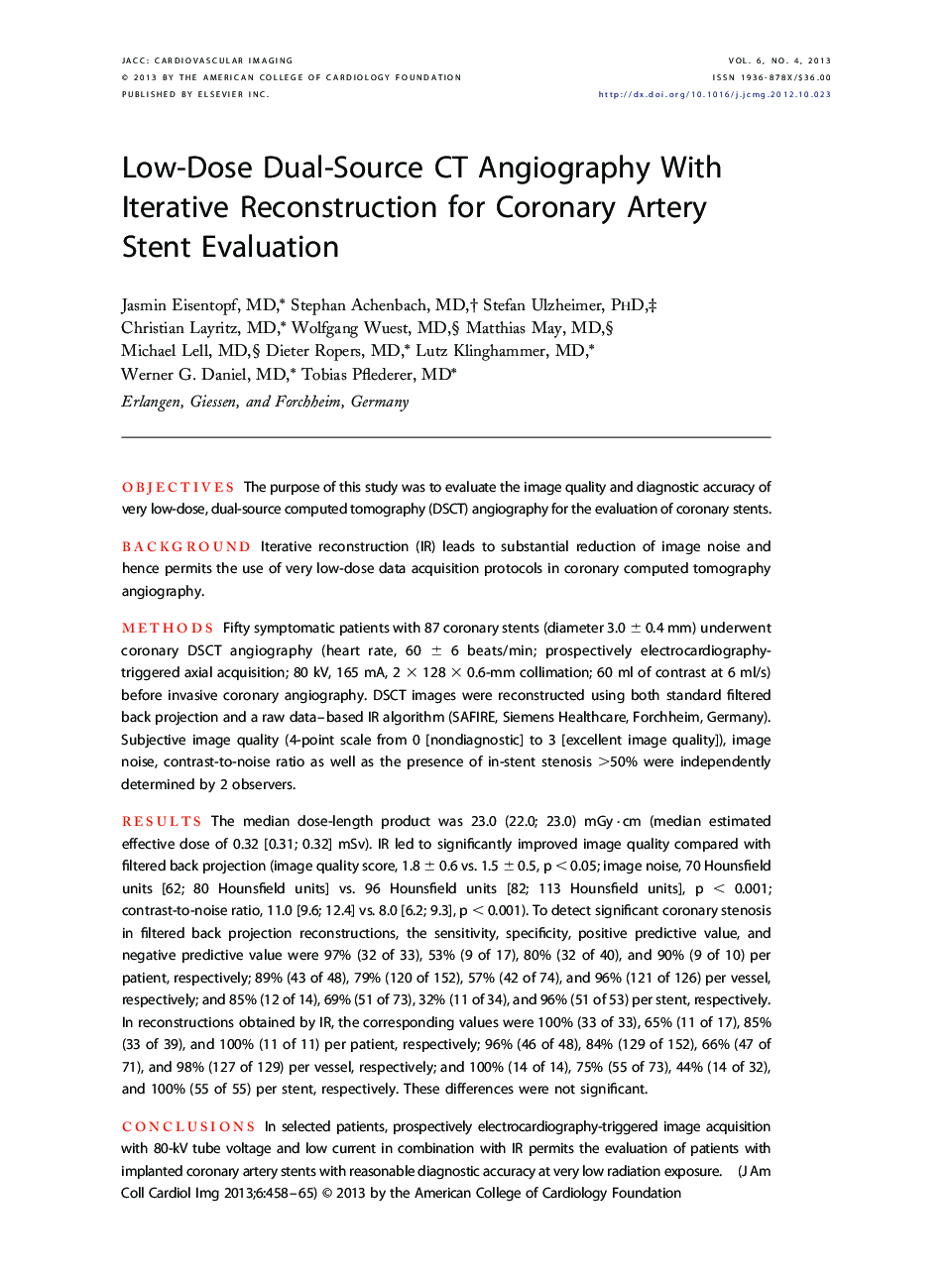| Article ID | Journal | Published Year | Pages | File Type |
|---|---|---|---|---|
| 2938231 | JACC: Cardiovascular Imaging | 2013 | 8 Pages |
ObjectivesThe purpose of this study was to evaluate the image quality and diagnostic accuracy of very low-dose, dual-source computed tomography (DSCT) angiography for the evaluation of coronary stents.BackgroundIterative reconstruction (IR) leads to substantial reduction of image noise and hence permits the use of very low-dose data acquisition protocols in coronary computed tomography angiography.MethodsFifty symptomatic patients with 87 coronary stents (diameter 3.0 ± 0.4 mm) underwent coronary DSCT angiography (heart rate, 60 ± 6 beats/min; prospectively electrocardiography-triggered axial acquisition; 80 kV, 165 mA, 2 × 128 × 0.6-mm collimation; 60 ml of contrast at 6 ml/s) before invasive coronary angiography. DSCT images were reconstructed using both standard filtered back projection and a raw data–based IR algorithm (SAFIRE, Siemens Healthcare, Forchheim, Germany). Subjective image quality (4-point scale from 0 [nondiagnostic] to 3 [excellent image quality]), image noise, contrast-to-noise ratio as well as the presence of in-stent stenosis >50% were independently determined by 2 observers.ResultsThe median dose-length product was 23.0 (22.0; 23.0) mGy · cm (median estimated effective dose of 0.32 [0.31; 0.32] mSv). IR led to significantly improved image quality compared with filtered back projection (image quality score, 1.8 ± 0.6 vs. 1.5 ± 0.5, p < 0.05; image noise, 70 Hounsfield units [62; 80 Hounsfield units] vs. 96 Hounsfield units [82; 113 Hounsfield units], p < 0.001; contrast-to-noise ratio, 11.0 [9.6; 12.4] vs. 8.0 [6.2; 9.3], p < 0.001). To detect significant coronary stenosis in filtered back projection reconstructions, the sensitivity, specificity, positive predictive value, and negative predictive value were 97% (32 of 33), 53% (9 of 17), 80% (32 of 40), and 90% (9 of 10) per patient, respectively; 89% (43 of 48), 79% (120 of 152), 57% (42 of 74), and 96% (121 of 126) per vessel, respectively; and 85% (12 of 14), 69% (51 of 73), 32% (11 of 34), and 96% (51 of 53) per stent, respectively. In reconstructions obtained by IR, the corresponding values were 100% (33 of 33), 65% (11 of 17), 85% (33 of 39), and 100% (11 of 11) per patient, respectively; 96% (46 of 48), 84% (129 of 152), 66% (47 of 71), and 98% (127 of 129) per vessel, respectively; and 100% (14 of 14), 75% (55 of 73), 44% (14 of 32), and 100% (55 of 55) per stent, respectively. These differences were not significant.ConclusionsIn selected patients, prospectively electrocardiography-triggered image acquisition with 80-kV tube voltage and low current in combination with IR permits the evaluation of patients with implanted coronary artery stents with reasonable diagnostic accuracy at very low radiation exposure.
